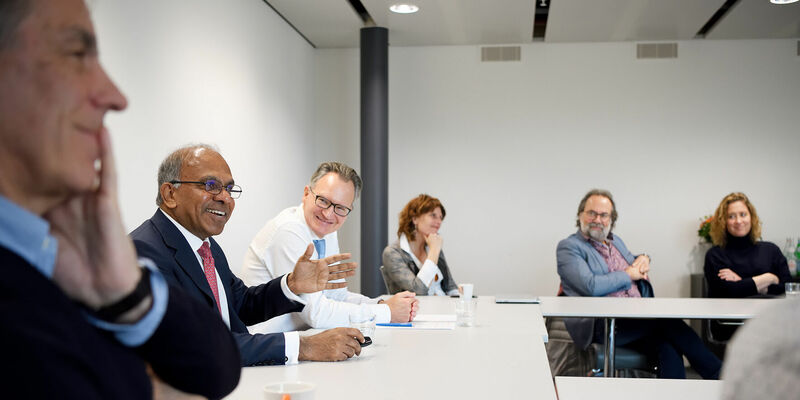
- The University , Campus
- 03/12/2019
President of NTU Singapore seeks cooperation with TU/e
TU/e has been wrestling with a strong student inflow in recent years, whereas the Nanyang Technological University, Singapore’s second university, needs to prepare for a decline in the number of students. The reason for this is the decline in the number of young people in this city-state in Southeast Asia. However, NTU president Subra Suresh, who visited TU/e yesterday, mainly sees similarities between the two institutions, as well as opportunities for cooperation.
Professor Subra Suresh, who has been in charge of NTU since the beginning of 2018, was invited to visit Eindhoven before attending a meeting in Brussels by TU/e’s president of the Executive Board Robert-Jan Smits. Suresh and Smits have known each other for a long time, and the latter wanted to invite the NTU president to his university. Yesterday, Suresh visited the lab of professor Carlijn Bouten of Soft Tissue Engineering, gave a lecture to deans, scientists and directors, and made himself available for a forty-five-minute interview with Cursor.
“NTU is a young university,” Suresh emphasizes. “We were founded in 1991, but the university has grown quickly in that short period, and it has managed to move up in several prominent rankings.” NTU has approximately twice as many students and staff members as TU/e. But while the strong growth of student numbers in recent years sometimes leads to worries at TU/e, Suresh needs to come up with a plan to cope with the decline in student inflow within the foreseeable future. “The number of young people in Singapore is declining, so that will eventually lead to less inflow. We need to consider how we can tackle that problem.”
Cooperation with the business sector
Suresh says that NTU was able to successfully develop thanks to the structural support from the government, the regional and international business sector, and the people of Singapore. “Our close cooperation with the business sector is an important factor in particular. Companies, such as Rolls Royce, have their labs on our campus. We conduct joint research there and our students can find internships there, and perhaps their first job at a later stage.” In total, NTU collaborates with more than two hundred companies.
The Singapore government is strongly convinced of the need for sound technical education and research, and generously supports this financially. “Excellence plays a key role in that,” Suresh says, “and if the university remains true to that, it will have an effect on recruiting talent.” Because recruiting top scientists is of crucial importance to both TU/e and NTU. Suresh says that NTU uses a rather unorthodox system for its postdocs. “In Singapore, our professors don’t get the money with which they can appoint a postdoc, instead, the money goes directly to the postdoc and it’s up to the professors to do their best to engage the postdoc. Obviously, this is a very attractive construction for the postdoc, who gets to make the decision.”
Sustainability
There are also similarities between NTU and TU/e when it comes to developing innovative methods for offering education, recruiting female scientists, and paying more attention to the issue of student wellbeing, since students are under increasing pressure worldwide, according to Suresh.
Designing its own campus and buildings as a living lab when it comes to sustainability are also high on NTU’s agenda. 95 percent of NTU’s 234 buildings are part of so-called Green Mark-certified projects, and in 2025, the university wants to consume fifty percent less energy and water compared to 2011. Suresh: “We place more and more solar panels to accomplish this, and we use a part of our waste for energy generation.”
Asia
When asked about the rise of universities in Asia and how western universities should respond to that, Suresh replies: “You see that the development of research and education at universities in China and India is moving faster and faster. You also see that reflected each year in the international rankings. NTU is not far away, many of our researchers have Chinese or Indian roots, and that’s why we have many contacts and partnerships with these emerging universities. My advice to the academic world here is to continue to work hard, because in Asia there is a great drive to close the gap.”
Suresh is very enthusiastic about what he has seen of TU/e during this short period, and he certainly doesn’t rule out the possibility of a cooperation. “Let’s start on a small scale, for instance with the exchange of students, PhD candidates and postdocs. Or let’s look into a possible cooperation with companies that both our universities work with. From there, it can continue to grow.”
Discussion